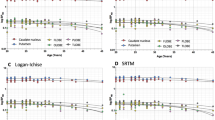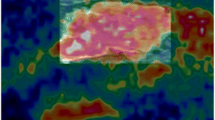Abstract
The effects of age on the binding parameters of11C-SCH23390, the highly selective ligand for central D1 dopamine receptors, at specific binding sites in the brain were studied. Seventeen healthy male volunteers (20–72 years old) participated. Regional radioactivity in the brain was followed for 40 min by positron emission tomography (PET). A high accumulation of radioactivity was observed in the striatum and there was a conspicuous accumulation in the neocortex. A two-compartment model was used to obtain quantitative estimates of rate constants of association (k3) and dissociation (k4). The binding potential (k3/k4) of the dopamine D1 receptors in the striatum and frontal cortex decreased by 35% and 39%, respectively, with age. The value of k3 decreased by 58% in the striatum and 83% in the frontal cortex, whereas the value of k4 decreased by 35% in the striatum and 72% in the frontal cortex with age.
Similar content being viewed by others
References
Andersen PH, Grønvald FC (1986) Specific binding of3H-SCH23390 to dopamine D1 receptors in vivo. Life Sci 38:1507–1514
Arnt J (1985) Behavioural stimulation is induced by separate dopamine D-1 and D-2 receptor sites in reserpine-pretreated but not in normal rats. Eur J Pharmacol 113:79–88
Baron JC, Mazière B, Loc'h C, Cambon H, Sgouropoulos P, Bonnet AM, Agid Y (1986) Loss of striatal [76Br]bromospiperone binding sites demonstrated by positron tomography in progressive supranuclear palsy. J Cereb Blood Flow Metab 6:131–136
Battaglia G, Norman AB, Creese I (1988) Age-related differential recovery rate of rat striatal D-1 dopamine receptors following irreversible inactivation. Eur J Pharmacol 145:281–290
Bischoff S, Heinrich M, Sonntag JM, Krauss J (1986) The D-1 dopamine receptor antagonist SCH23390 also potently with brain serotonin (5-HT2) receptors. Eur J Pharmacol 129:367–370
Cortés R, Gueye B, Pazos A, Probst A, Palacios JM (1989) Dopamine receptors in human brain: autoradiographic distribution of D1 sites. Neuroscience 28:263–273
De Keyser J, Claeys A, De Backer JP, Ebinger G, Roels F, Vauquelin G (1988) Autoradiographic localization of D1 and D2 dopamine receptors in the human brain. Neurosci Lett 91:142–147
Eckernâs S-A, Aquilonius SM, Hartvig P, Hagglund J, Lundqvist H, Nagren K, Långström B (1987) Positron emission tomography (PET) in the primate brain: evaluation of a kinetic model using11C-N-methyl-spiperone. Acta Neurol Scand 75:168–178
Farde L, Halldin C, Stone-Elander S, Sedvall G (1987) PET analysis of human dopamine receptor subtypes using11C-SCH23390 and11C-raclopride. Psychopharmacology 92:278–284
Filloux FM, Wamsley JK, Dawson TM (1987) Presynaptic and postsynaptic D1 dopamine receptors in the nigrostriatal system of the rat brain: a quantitative autoradiographic study using the selective D1 antagonist [3H]SCH23390. Brain Res 408:250–209
Frost JJ, Douglass KH, Mayberg HS, Dannals RF, Links JM, Wilson AA, Ravert HT, Crozier WC, Wagner HN Jr (1989) Multicompartmental analysis of [11C]-carfentanil binding to opiate receptors in humans measured by positron emission tomography. J Cereb Blood Flow Metab 9:398–409
Gelbard HA, Teicher MH, Faedda G, Baldessarini RJ (1989) Postnatal development of dopamine D1 and D2 receptor sites in rat striatum. Brain Res 49:123–130
Giorgi O, De Montis G, Porceddu ML, Mele S, Calderini G, Toffano G, Biggio G (1987) Developmental and age-related changes in D1-dopamine receptors and dopamine content in the rat striatum. Dev Brain Res 35:283–290
Hess EJ, Bracha HS, Kleinman JE, Creese I (1987) Dopamine receptor subtype imbalance in schizophrenia. Life Sci 40:1487–1497
Hyttel J (1983) SCH23390 — the first selective dopamine D1 antagonist. Eur J Pharmacol 91:153–154
Hyttel J (1989) Parallel decrease in the density of dopamine D1 and D2 receptors in corpus striatum of rats from 3 to 25 month age. Pharmacol Toxicol 64:55–57
Iorio LC (1981) SCH23390. A benzazepine with atypical effects on dopaminergic systems. Pharmacologist 23:136
Lundberg T, Lindstöm LH, Hartvig P, Eckernâs SA, Ekblom B, Lundqvist H, Fasth KJ, Gullberg P, Långström B (1989) Striatal and frontal cortex binding of 11-C-labelled clozapine visualized by positron emission tomography (PET) in drug-free schizophrenics and healthy volunteers. Psychopharmacology 99:8–12
Matui T, Hirano A (1977) An atlas of the human brain for computerized tomography. Igaku Shoin Ltd, Tokyo
Mintun MA, Raichle ME, Kilbourn MR, Wooten GF, Welch M (1984) A quantitative model for the in vivo assessment of drug binding sites with positron emission tomography. Ann Neurol 15:217–227
Molloy AG, Waddington JL (1988) Behavioural responses to the selective D1-dopamine receptor agonist R-SK&F38393 and the selective D2-agonist RU24213 in young compared with aged rats. Br J Pharmacol 95:335–342
Morgan DG, Marcusson JO, Nyberg P, Wester P, Winblad B, Gorden MN, Finch CE (1987) Divergent change in D-1 and D-2 dopamine binding sites in human brain during aging. Neurobiol Aging 8:195–201
O'Boyle KM, Waddington JL (1984) Loss of rat striatal dopamine receptors with aging is selective for D-2 but not D-1 sites: association with increased non-specific binding of the D-1 ligand [3H]piflutixol. Eur J Pharmacol 105:171–174
Pantano P, Baron JC, Lebrun-Grandie P, Duquesnoy N, Bousser MG, Comar D (1984) Regional cerebral blood flow and oxygen consumption in human aging. Stroke 15:635–641
Reader TA, Brière R, Gottberg E, Diop L, Grondin L (1988) Specific [3H]SCH23390 binding to dopamine D1 receptors in cerebral cortex and neostriatum: evidence for heterogeneities in affinity state and cortical distribution. J Neurochem 50:451–463
Rinne JO (1987) Muscarinic and dopaminergic receptors in the aging human brain. Brain Res 404:162–168
Saller CF, Salama AI (1985) Dopamine receptor subtypes: in vivo biochemical evidence for functional interaction. Eur J Pharmacol 109:297–300
Schultz DW, Wyrick SD, Mailman RB (1985)3H-SCH23390 has the characteristics of a dopamine receptor ligand in rat central nervous system. Eur J Pharmacol 106:211–212
Savasta M, Dubois A, Scatton B (1986) Autoradiographic localization of D1 dopamine receptors in the rat brain with [3H]SCH23390. Brain Res 375:291–301
Seeman P, Bzowej NH, Guan HC, Bergeron C, Becker LE, Reynolds GP, Bird ED, Riederer P, Jellinger K, Watanabe S, Tourtellotte WW (1987) Human brain dopamine receptors in children and aging adults. Synapse 1:399–404
Severson JA, Finch CE (1980) Reduced dopaminergic binding during aging in the rodent striatum. Brain Res 192:147–162
Severson JA, Marcusson J, Winblad B, Finch CE (1982) Age-correlated loss of dopaminergic binding sites in human basal ganglia. J Neurochem 39:1623–1631
Suzuki K, Inoue O, Hashimoto K, Yamasaki T, Kuchiki M, Tamate K (1985) Computer-controlled large scale production of high specific activity [11C]Ro15-1788 for PET studies of benzodiazepine receptors. Int J Appl Radiat lsot 36:971–976
Takami K, Ueda K, Okajima K, Tanaka E, Nohara N, Tomitani T, Murayama H, Shishido F, Ishimatu K, Ohgushi S, Inoue Y, Takakusa Y, Hayashi T, Nakase S (1983) Performance study of whole-body, multislice positron computed tomograph-positrosica II. IEEE Trans Nucl Sci NS-30:734–738
Wong DF, Wagner HN Jr, Dannals RF, Links JM, Frost JJ, Ravert HT, Wilson AA, Rosenbaum AE, Gjedde A, Douglass KH, Petronis JD, Folstein MF, Tung JKT, Burns D, Kuhar MJ (1984) Effects of age on dopamine and serotonin receptors measured by positron tomography in living human brain. Science 226:1393–1396
Author information
Authors and Affiliations
Rights and permissions
About this article
Cite this article
Suhara, T., Fukuda, H., Inoue, O. et al. Age-related changes in human D1 dopamine receptors measured by positron emission tomography. Psychopharmacology 103, 41–45 (1991). https://doi.org/10.1007/BF02244071
Received:
Revised:
Issue Date:
DOI: https://doi.org/10.1007/BF02244071




